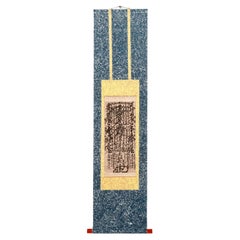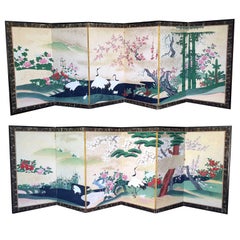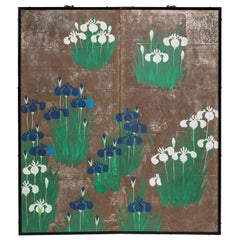1810s Paintings and Screens
2
to
2
2
2
2
163
574
893
179
307
217
121
37
4
29
18
14
21
24
22
22
9
2
1
1
1
2
2
2
Period: 1810s
Early Japanese Gohonzon Buddhist Calligraphy Mandala Scroll Edo Period
Located in Atlanta, GA
A Japanese sumi ink calligraphy Buddhist mandala mounted as a paper hanging scroll known as Kakejiku or sometimes Moji mandala. Termed as gohonzon in Japanese, it is a venerated object within Nichiren Buddhism (Hokkeshu; lotus sect). The originally concept was developed by the 13th century Buddhist priest Nichiren to guide the energy of the devotional chanting to...
Category
Japanese Edo Antique 1810s Paintings and Screens
Materials
Paper
Pair of Rare Antique Japanese Folding Screens with Provenance
Located in Atlanta, GA
An amazing pair of matching antique Japanese folding screen predating 1812-1813, most likely from Kano School. Six panels each depict C...
Category
Japanese Japonisme Antique 1810s Paintings and Screens
Materials
Brass
Related Items
Hand Painted Japanese Folding Screen Byobu of Camellias
Located in 10 Chater Road, HK
The camellias painting of this two-panel screen is hand-painted in watercolor, on squares of gold leaf which are applied by hand to the paper base ov...
Category
Chinese 1810s Paintings and Screens
Materials
Gold Leaf
Hand Painted Japanese Folding Screen Byobu of Irises
Located in 10 Chater Road, HK
The irises painting of this two-panel screen is hand-painted in watercolor, on squares of silver leaf which are applied by hand to the paper base over carefully jointed wooden lattic...
Category
Chinese 1810s Paintings and Screens
Materials
Silver Leaf
Vintage Japanese "Flower Cart" Folding Screen
Located in New York, NY
A traditional style Japanese four panel folding screen depicting a flower cart full of red and white flowers.
10198
Category
Japanese 1810s Paintings and Screens
Japanese 4 Panel Folding Screen with Eight Samurai
Located in New York, NY
A Japanese folding screen with four panels depicting eight seated samurai in a structure surrounded by trees on a gold background.
10197
Category
Japanese Antique 1810s Paintings and Screens
Materials
Paper
Pair of Chinoiserie Hand-Painted Paper Panels, Watercolor on Paper
Located in 10 Chater Road, HK
Original paintings, inspired by antique Chinese export wallpapers., from our studio.
An antiquing process is applied to the paintings for a distressed effect.
Category
Chinese Chinese Export 1810s Paintings and Screens
Materials
Paper
Japanese Edo Period Two-Panel Screen
Located in Stamford, CT
A Japanese Edo Period two panel folding screen with white and brown hawks of ink and color on paper.
Category
Japanese Edo Antique 1810s Paintings and Screens
Materials
Paper
Japanese 2-Panel Furosaki’byôbu 風炉先屏風 'Tea-Ceremony Folding Screen' with Dragons
Located in Amsterdam, NL
A striking low and wide two-panel furosaki’byôbu (tea-ceremony room divider) painted with two bright white dragons (ryû) flying amidst swirling black clouds. The left dragon holds a ...
Category
Japanese 1810s Paintings and Screens
Materials
Wood, Paper
Free Shipping
H 31.26 in W 73.08 in D 0.67 in
Large Japanese 6-panel byôbu 屏風 (folding screen) with genre painting
Located in Amsterdam, NL
Fascinating large six-panel byôbu (folding screen) with a detailed genre painting on goldish silver leaf with different scenes of people at work in a rural mountain village during th...
Category
Japanese 1810s Paintings and Screens
Materials
Silver Leaf
Free Shipping
H 67.84 in W 147.17 in D 0.75 in
Hand Painted Japanese Folding Screen Byobu of Hawks
Located in 10 Chater Road, HK
The hawks painting of this four-panel screen is hand-painted in watercolor, on squares of silver leaf which are applied by hand to the paper base over carefully jointed wooden lattic...
Category
Chinese 1810s Paintings and Screens
Materials
Silver Leaf
Antique hanging scroll of Japanese cat/Late Edo-Meiji period/Cat painting
Located in Sammu-shi, Chiba
This is a picture of a cat drawn by a person named "Toshizumi Nitta" from the end of the Edo period to the beginning of the Meiji period.
She is a very simple and cute cat.
He is a vassal of the Tokugawa Shogunate, born in Ota City, Gunma Prefecture (southern part of Gunma Prefecture).
He was related to the Tokugawa family and lived in a large mansion in the Ota clan in Gunma prefecture.
However, the Nitta family's territory was very small, and they were by no means a wealthy vassal.
He seems to have lived quite poorly.
So he painted cats and sold them to people.
The Nitta family continued to draw pictures of this cat for four generations.
"Nitta toshizumi" is equivalent to the fourth generation.
During the Edo period, sericulture was thriving in the Kanto region.
Cats were said to be the gods of silkworms, as they drive away mice, the natural enemies of silkworms.
It was the Nitta family who drew such a cat on paper, pasted it in the silkworm chamber, and sold it as a mouse repellent.
There were also other monks who painted pictures of cats, but the Nitta family in particular was related to the Tokugawa family, so people believed that paintings of cats had special powers. , a lot of paintings...
Category
Japanese Edo Antique 1810s Paintings and Screens
Materials
Paper
H 41.93 in W 18.71 in D 0.08 in
Chinese Lacquered Six Panel Screen
Located in Cypress, CA
Impressive Chinese lacquered and parcel gilt six panel screen.
Mid 20th century
Each lacquered and parcel gilt decorated panel is separated into fo...
Category
Chinese 1810s Paintings and Screens
Materials
Wood
Large Japanese 6-panel byôbu 屏風 (folding screen) with chrysanthemum garden
Located in Amsterdam, NL
A very colourful and captivating large six-panel byôbu (folding screen) with a refined continuous painting of a luscious flower garden filled with many different types of chrysanthemums (kiku), next to a winding river.
This multi-coloured painting is set on a shiny gold-leaf background, and the chrysanthemum flowers are painted by using shell paste (gofun) in low relief.
Several clutches with a great variety of chrysanthemum flowers are in full bloom and they each show their unique form and colour. Varying from white, red, yellow and pink. The flowers bloom all around and on different kinds of bamboo fences and trellises.
In Japan chrysanthemums are believed to represent happiness, love, longevity and joy.
The panels are surrounded by two silk borders, a thin black one, and a wide brown one. The screen is protected by a black and red negoro’nuri...
Category
Japanese Antique 1810s Paintings and Screens
Materials
Gold Leaf
Free Shipping
H 68.23 in W 144.89 in D 0.6 in
Recently Viewed
View AllMore Ways To Browse
Antique Japanese Painting On Silk
Antique Japanese Paintings On Silk
Japanese Panel Folding
Japanese Edo Screens
Chinese Screen Two
Edo Panel
Japanese Pictures
Hand Painted Antique Screen
Vintage Asian Painting
Japanese Meiji Screen
Chinese Panel Lacquered Screen
Antique Door Screen
Antique Screen Doors
Chinese 4 Panel
Carved Window Panels
4 Panel Chinese
Black Lacquer Asian Painting
Asian Lattice



